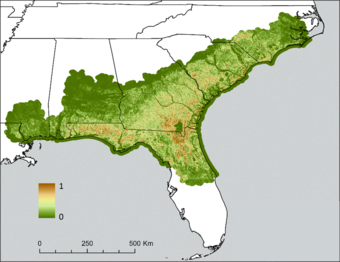Population Persistence of the Ornate Chorus Frog Across Its Distribution
The ornate chorus frog, once common throughout its range, appears to be experiencing population declines. USGS has partnered with the Florida Fish and Wildlife Conservation Commission to assess the ornate chorus frog population status across its distribution.

The Science Issue and Relevance: The ornate chorus frog (Pseudacris ornata) is a winter-breeding amphibian that may be declining across much of its distribution in the Southeast USA. Few studies, however, have focused on range-wide ornate chorus frog population trends. Assessments of species status are imperative for identifying which species are at risk and why. This information could then guide conservation and management efforts towards halting or reversing declining populations trends. This is particularly true for species like the ornate chorus frog that are sensitive to changing environmental conditions.
Methodology for Addressing the Issue: WARC researchers built a maximum entropy (MaxEnt) model to describe environmental suitability for the ornate chorus frog. Then, in collaboration with the Florida Fish and Wildlife Conservation Commission, presence-only records from across the historic distribution of the species were used to model the probability that historic ornate chorus frog populations still persist.
Future Steps: This study will identify portions of the historic ornate chorus frog distribution where they may no longer occur. Without knowledge of recent population trends, range contraction, or the causes of such changes, conservation efforts and protections cannot be initiated.

The ornate chorus frog, once common throughout its range, appears to be experiencing population declines. USGS has partnered with the Florida Fish and Wildlife Conservation Commission to assess the ornate chorus frog population status across its distribution.

The Science Issue and Relevance: The ornate chorus frog (Pseudacris ornata) is a winter-breeding amphibian that may be declining across much of its distribution in the Southeast USA. Few studies, however, have focused on range-wide ornate chorus frog population trends. Assessments of species status are imperative for identifying which species are at risk and why. This information could then guide conservation and management efforts towards halting or reversing declining populations trends. This is particularly true for species like the ornate chorus frog that are sensitive to changing environmental conditions.
Methodology for Addressing the Issue: WARC researchers built a maximum entropy (MaxEnt) model to describe environmental suitability for the ornate chorus frog. Then, in collaboration with the Florida Fish and Wildlife Conservation Commission, presence-only records from across the historic distribution of the species were used to model the probability that historic ornate chorus frog populations still persist.
Future Steps: This study will identify portions of the historic ornate chorus frog distribution where they may no longer occur. Without knowledge of recent population trends, range contraction, or the causes of such changes, conservation efforts and protections cannot be initiated.


